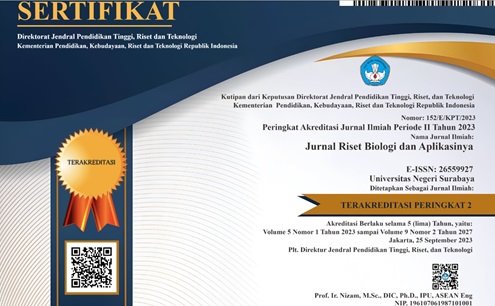The Effect of Water Concentration on Growth Media on Lipid Production by Oleaginous Fungi Isolate BR 2.2
DOI:
https://doi.org/10.26740/jrba.v4n2.p51-56Keywords:
Oleaginous fungi, glucose, water content, lipid, biomassAbstract
Oleaginous fungi are one of the microorganisms that can accumulate a high number of biomasses quickly (within 96-130 hours) and are often used to produce lipids. The growth of fungi depends on the chemical composition of the environment in which it grows. The growth media of fungi must contain high carbohydrates as a source of nutrients and high nitrogen content. One of the carbon sources that fungi can use in the growth process is glucose. BR 2.2 isolate is an oleaginous fungus capable of accumulating 28.44% lipids from the total dry biomass with glucose as a carbon source in 50 mL of growth media. Therefore, this study was conducted to determine the effect of variations in the volume of media and incubation time on the production of biomass and lipid isolate BR 2.2. Biomass and lipid production were analyzed at media with additional water volumes of 10, 20, 30, 40, and 50 mL with 48, 96, and 144 hours of incubation times. The results showed that lipid accumulation and biomass production increased with the reduction of water content in the growth media and reached the highest number in the media volume of 20 mL with an incubation time of 144 hours, i.e., 0.87±0.04 g/L and 12.53±0.29 g/L. It can be concluded that biomass and fungal lipid increased along with incubation time and nutrient concentration.
References
Asadollahzadeh, M., Ghasemian, A., Saraeian, A., Resalati, H., & Taherzadeh, M. J. (2018). Production of fungal biomass protein by filamentous fungi cultivation on liquid waste streams from pulping process, BioRes, 13(3), 5013-5031. https://bioresources.cnr.ncsu.edu/resources/production-of-fungal-biomass-protein-by-filamentous-fungi-cultivation-on-liquid-waste-streams-from-pulping-process/
Axelsson, M., & Gentili, F. (2014). A single-step method for rapid extraction of total lipids from green microalgae. PLoS ONE, 9(2), e89643. https://doi.org/10.1371/journal.pone.0089643
Basu, S., Bose, C., Ojha, N., Das, N., Das, J., Pal, M., & Khurana, S. (2015). Evolution of bacterial and fungal growth media. Bioinformation, 11(4),182. https://doi.org/10.6026%2F97320630011182
Dey, P., Mall, N., Chattopadhyay, A., Chakraborty, M., & Maiti, M. K. (2014). Enhancement of lipid productivity in oleaginous colletotrichum fungus through genetic transformation using the yeast ctDGAT2b gene under model-optimized growth condition. PLoS ONE, 9(11), e0187171. https://doi.org/10.1371/journal.pone.0111253
Fifendy, M. (2017). Mikrobiologi. Depok: Kencana
Meeuwse, P. (2011). Production of fungal lipids Kinetic modeling and process design. The Netherlands
Murwani, S. (2015). Dasar-dasar Mikrobiologi Veteriner. Malang: UB Press. pp 151-151
Rizki, M. A. A. H., & Ilmi, M. (2021). The Potential of Oleaginous Filamentous Fungi Isolated from Soil of Baturraden Botanical Garden, Central Java, Indonesia. IOP Conference Series: Earth and Environmental Science, 736(1). https://doi.org/10.1088/1755-1315/736/1/012060
Shafiq, S. A., & Chechan, R. A. (2019). Influence of different natural media on production of myco-diesel. IOP Conference Series: Earth and Environmental Science, 388(1). https://doi.org/10.1088/1755-1315/388/1/012054
Downloads
Published
How to Cite
Issue
Section
License
Copyright (c) 2022 Jurnal Riset Biologi dan Aplikasinya

This work is licensed under a Creative Commons Attribution-NonCommercial 4.0 International License.
 Abstract views: 421
,
Abstract views: 421
, PDF Downloads: 141
PDF Downloads: 141












